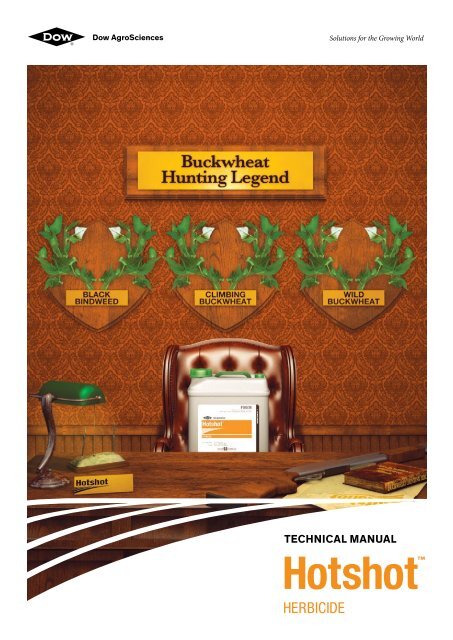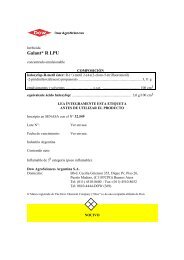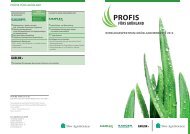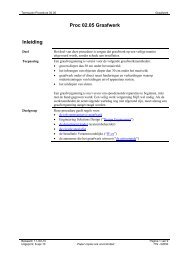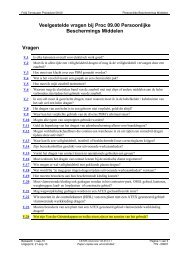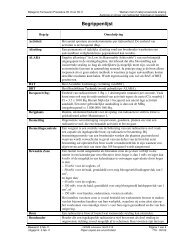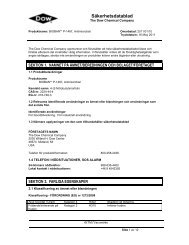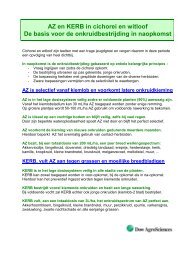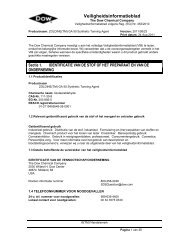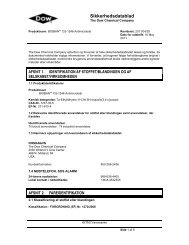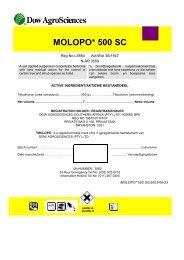Technical Manual - The Dow Chemical Company
Technical Manual - The Dow Chemical Company
Technical Manual - The Dow Chemical Company
You also want an ePaper? Increase the reach of your titles
YUMPU automatically turns print PDFs into web optimized ePapers that Google loves.
Herbicide<br />
www.dowagrosciences.com.au<br />
<strong>Technical</strong> <strong>Manual</strong><br />
® Trademark of <strong>The</strong> <strong>Dow</strong> <strong>Chemical</strong> <strong>Company</strong> (“<strong>Dow</strong>”) or an affiliated company of <strong>Dow</strong>
GAME<br />
CHANGING<br />
PRODUCTS<br />
SECURING WORLD<br />
FOOD DEMANDS<br />
40 COUNTRIES<br />
WhaT DOeS all<br />
ThiS Mean TO YOu?<br />
2000<br />
SCIENTISTS<br />
Confidence<br />
in a drum
3<br />
cOnTenTS<br />
Introduction 3<br />
Hotshot TM for hard-to-kill weeds 4<br />
Efficacy on climbing buckwheat (black bindweed) 5<br />
Weed Spectrum 6<br />
Residual control of climbing buckwheat 8<br />
Plantback periods 8<br />
Crop growth stages 9<br />
Crop safety 10<br />
Crop safety summary 11<br />
Directions for use 12<br />
Resistance management 13<br />
Mixing and application method 14<br />
Product compatibility 14<br />
Withholding periods 14<br />
Demonstration data 15<br />
inTrODucTiOn<br />
For cereal producers, climbing buckwheat (black<br />
bindweed) was once a nightmare to control in winter<br />
barley, oats, wheat and triticale. Unreliable herbicide<br />
options in tough or marginal conditions meant poor<br />
control in-crop and further infestations in fallow.<br />
Enter Hotshot Herbicide<br />
Hotshot has set the standard for climbing buckwheat<br />
control. Providing robust performance in even the harshest<br />
conditions, Hotshot also offers high crop safety combined<br />
with excellent residual for effective control of secondary<br />
germinations and a cleaner fallow.<br />
In this brochure you will find the results of extensive<br />
trials with Hotshot conducted in Australia along with vital<br />
product information such as weed susceptibility, product<br />
compatibility and plantback periods.<br />
For any further information, please contact your local <strong>Dow</strong> AgroSciences<br />
Territory Manager or call direct on 1800 700 096.<br />
www.dowagrosciences.com.au<br />
® Trademark of <strong>The</strong> <strong>Dow</strong> <strong>Chemical</strong> <strong>Company</strong> (“<strong>Dow</strong>”) or an affiliated company of <strong>Dow</strong>
4<br />
hOTShOT fOr harD-TO-Kill WeeDS<br />
Hotshot for hard-to-kill weeds<br />
Hotshot contains fluroxypyr and <strong>Dow</strong> AgroSciences’ latest<br />
molecule, aminopyralid. Aminopyralid is a pyridine carboxylic<br />
acid discovered and developed for use as a selective, post-<br />
emergent herbicide to control key broadleaf weeds. It is a<br />
new generation active ingredient that is effective at very low<br />
rates when compared with other herbicides.<br />
Herbicidal activity<br />
Hotshot is a systemic, phloem and xylem mobile herbicide<br />
that is rapidly absorbed by leaves and roots. Symptoms<br />
are typical of those for the auxinic mode of action (Group<br />
I). Within hours of application depending on weed species,<br />
Key attribute Benefit<br />
Robust climbing buckwheat (black bindweed) control Effective control even in tough conditions<br />
Effective control of small (up to 4 leaf) and large (up to 8 leaf) climbing buckwheat Wide weed application window to get effective control<br />
Residual control of climbing buckwheat Fewer germinations and a cleaner start to summer fallow<br />
Excellent crop safety Improved crop yields<br />
Compatible with MCPA LVE and metsulfuron-methyl <strong>The</strong> mixture controls all key broadleaf weeds<br />
Compatible with Topik ® 240EC Herbicide One-pass weed control<br />
Group I mode of action<br />
www.dowagrosciences.com.au<br />
the aminopyralid causes symptoms such as thickened,<br />
curved and twisted stems and leaves, cupping and crinkling<br />
of leaves, stem cracking, narrow leaves with callus tissue,<br />
hardened growth on stems, enlarged roots and proliferated<br />
growth.<br />
Mode of action<br />
<strong>The</strong>re are clear benefits for integrating Hotshot into your weed control program<br />
<strong>The</strong> aminopyralid in Hotshot moves systemically throughout<br />
the plant and deregulates metabolic pathways affecting the<br />
growth processes of the plant. This disruption occurs when<br />
aminopyralid binds at receptor sites normally used by the<br />
plant’s natural growth hormones and results in control and<br />
death of susceptible plant species.<br />
Provides an alternative to ALS-inhibitor herbicides for ALS herbicide<br />
resistant weeds<br />
Untreated 66 DAA Hotshot @ 750 mL/ha, 66 DAA<br />
2005 demonstration site, North Star Road (Trial 054008RA) DAA = days after application<br />
® Trademark of <strong>The</strong> <strong>Dow</strong> <strong>Chemical</strong> <strong>Company</strong> (“<strong>Dow</strong>”) or an affiliated company of <strong>Dow</strong>
5<br />
efficacY On cliMBinG BucKWheaT<br />
Control of climbing buckwheat (Number of Trials)<br />
www.dowagrosciences.com.au<br />
<strong>Dow</strong> AgroSciences has conducted trials with Hotshot<br />
Herbicide on climbing buckwheat since 2002. Hotshot<br />
has been compared to current standards on climbing<br />
buckwheat. As shown in the summary below, Hotshot<br />
@ 500 mL/ha showed similar efficacy on climbing<br />
buckwheat as the best standard Tordon TM 242 Cereal<br />
Herbicide whereas Hotshot @ 750 mL/ha was the most<br />
reliable treatment across all seasons.<br />
Across three seasons, Hotshot @ 500 mL/ha or 750<br />
mL/ha gave the best control of climbing buckwheat, as<br />
shown in the summary below.<br />
Control of climbing buckwheat 2002 to 2004<br />
(three seasons)<br />
TM Trademark of <strong>The</strong> <strong>Dow</strong> <strong>Chemical</strong> <strong>Company</strong> (“<strong>Dow</strong>”) or an affiliated company of <strong>Dow</strong>
6<br />
WeeD SPecTruM<br />
Weeds controlled<br />
How to use<br />
Hotshot Summary<br />
www.dowagrosciences.com.au<br />
hotshot herbicide hotshot + Metsulfuron hotshot + McPa lVe hotshot + Topik 240 ec<br />
Climbing buckwheat Climbing buckwheat Climbing buckwheat Climbing buckwheat<br />
Prickly lettuce Prickly lettuce Prickly lettuce Prickly lettuce<br />
Vetch Vetch Vetch Vetch<br />
Volunteer chickpea Volunteer chickpea Volunteer chickpea Volunteer chickpea<br />
Volunteer faba bean Volunteer faba bean Volunteer faba bean Volunteer faba bean<br />
Volunteer pea Volunteer pea Volunteer pea Volunteer pea<br />
Use when climbing<br />
buckwheat is the dominant<br />
weed<br />
Common sowthistle Common sowthistle Wild oats<br />
Deadnettle Mustards<br />
Mustards Turnip weed<br />
New Zealand spinach Variegated thistle<br />
Spiny emex Volunteer canola<br />
Turnip weed Wild turnip<br />
Volunteer canola<br />
Wild turnip<br />
Wireweed<br />
Use where there is a wider<br />
weed spectrum and when<br />
plantback to following crops<br />
and ALS-resistant weeds are<br />
not considerations<br />
attribute hotshot<br />
Use when plantback<br />
to following crops and<br />
ALS-resistant weeds are a<br />
consideration<br />
Active ingredient 10 g/L aminopyralid + 140 g/L fluroxypyr<br />
Mode of action Group I herbicide<br />
Crop growth stage 3-4 leaf to first node<br />
Water rate (recommended minimum) 80 L/ha<br />
Plantback period – winter crops 4–6 months (Northern Grain Region)<br />
Plantback period – summer crops 3–9 months (Northern Grain Region)<br />
Withholding period 7 days (grazing)<br />
Formulation type EO (water in oil emulsion)<br />
Flammability Non-flammable<br />
Rainfast period After 1 hour<br />
Container size 5, 20, 110 L<br />
Poison Schedule S6<br />
Use where buckwheat and<br />
non-FOP resistant wild oats<br />
are present<br />
® Trademark of <strong>The</strong> <strong>Dow</strong> <strong>Chemical</strong> <strong>Company</strong> (“<strong>Dow</strong>”) or an affiliated company of <strong>Dow</strong>
7<br />
WeeD SPecTruM<br />
Weed<br />
www.dowagrosciences.com.au<br />
hotshot<br />
herbicide<br />
750 ml<br />
hotshot<br />
500 ml<br />
Herbicide rate per hectare<br />
hotshot 750 ml<br />
+ 5 g metsulfuron<br />
(600 g/kg)<br />
hotshot 750 ml<br />
+ 580 ml<br />
lVe 600 McPa<br />
Bittercress (Coronopus didymus) X X ••• ••• ••<br />
Canola (non IT) (Brassica x napus var.napus) X X ••• ••• •••<br />
Climbing buckwheat (2–4 leaf)<br />
(Fallopia convolvulus) (black bindweed) ••• ••• ••• ••• •••<br />
Climbing buckwheat (6–8 leaf) ••• •• ••• ••• ••<br />
Deadnettle (Lamium amplexicaule) • X ••• • X<br />
Fleabane (seedling) (Conyza bonariensis) •• • •• ••• ••<br />
Fumitory (Fumaria densiflora) •• • ••• •• •<br />
Indian hedge mustard (Sisymbrium orientale) X X ••• ••• •••<br />
London rocket (Sisymbrium irio) X X ••• ••• •••<br />
Lucerne (seedling) (Medicago sativa) •• •• ••• •• ••<br />
Marshmallow (Malva parviflora) •• • •• •• •<br />
Mexican poppy (Argemone mexicana) • • • •• •<br />
Mustards (Sisymbrium spp.) X X ••• ••• •••<br />
New Zealand spinach (Tetragonia tetragonioides) •• • ••• •• ••<br />
Prickly lettuce (Lactuca serriola) ••• ••• ••• ••• ••<br />
Saffron thistle (Carthamus lanatus) •• • •• ••• •••<br />
Shepherd’s purse (Capsella bursa-pastoris) X X ••• ••• •••<br />
Skeleton weed (Chondrilla juncea) •• • •• •• ••<br />
Sowthistle (Sonchus oleraceus) •• • •• ••• •••<br />
Spiny Emex (Emex australis) ••• •• ••• ••• •••<br />
Stinging nettle (Urtica urens) • • • •• •<br />
Turnip weed (Rapistrum rugosum) X X ••• ••• •••<br />
Variegated thistle (Silybum marianum) •• • •• ••• •••<br />
Vetch (Vicia sativa) ••• ••• ••• ••• ••<br />
Volunteer canola (Brassica x napus var.napus) X X ••• ••• •••<br />
Volunteer chickpea (Cicer arietinum) ••• ••• ••• ••• ••<br />
Volunteer faba bean (Vicia faba) ••• ••• ••• ••• ••<br />
Volunteer field pea (Pisum sativum) ••• ••• ••• ••• ••<br />
Volunteer sunflower (Helianthus annuus) •• • ••• ••• ••<br />
Wild radish (Raphanus raphanistrum) X X ••• ••• •••<br />
Wild turnip (Brassica tournefortii) X X ••• ••• •••<br />
Wireweed (Polygonum aviculare) •• • ••• •• •<br />
Key<br />
Good control ••• Moderate control •• Poor control • No control X<br />
Tordon 242<br />
herbicide<br />
1l<br />
® Trademark of <strong>The</strong> <strong>Dow</strong> <strong>Chemical</strong> <strong>Company</strong> (“<strong>Dow</strong>”) or an affiliated company of <strong>Dow</strong>
8<br />
reSiDual cOnTrOl Of cliMBinG BucKWheaT<br />
Hotshot Herbicide has shown effective residual control of secondary germinations of climbing buckwheat. This was clearly<br />
demonstrated in a trial conducted at Bellata, NSW in 2004 where control of second germinations of climbing buckwheat was<br />
effective 103 days after application (DAA).<br />
Starane TM Advanced + MCPA LVE, 103 DAA Hotshot @ 750 mL/ha, 103 DAA<br />
PlanTBacK PeriODS<br />
Minimum recropping periods<br />
Aminopyralid remains active in the soil for<br />
extended periods depending on rate of application,<br />
soil type (clay content), rainfall, temperature, humidity, soil<br />
moisture and soil organic matter. <strong>The</strong> table below shows<br />
plantback periods to particular crops following application<br />
of Hotshot in the Northern Grain Region.<br />
<strong>The</strong>se plantback periods are based on normal rainfall<br />
pattern. During drought conditions (or when rainfall is less<br />
than 100 mm for a period of four months or greater) the<br />
plantback period may be significantly longer.<br />
www.dowagrosciences.com.au<br />
Northern New South Wales and Queensland<br />
Plantback periods for rotational crops following application<br />
of Hotshot for rates up to 750 mL/ha on black cracking clay<br />
soils. (See table below.)<br />
Winter crop Plantback period (months) Summer crop Plantback period (months)<br />
Barley 4 Cotton 9<br />
Canola 4 Maize 5<br />
Chickpea 6 Mungbean 5<br />
Faba bean 6 Sorghum 3<br />
Lucerne 6 Soybean 5<br />
Wheat 4 Sunflower 5<br />
Southern New South Wales, Victoria, South Australia and<br />
Western Australia<br />
Plantback periods for rotational crops following application<br />
of Hotshot for rates up to 500 mL/ha. (See table at right.)<br />
Winter crop Plantback period (months)<br />
Barley, Canola, Wheat 9<br />
Chickpea, Faba bean, Field pea,<br />
Lucerne, Medic, Sub clover<br />
20<br />
® TM Trademark of <strong>The</strong> <strong>Dow</strong> <strong>Chemical</strong> <strong>Company</strong> (“<strong>Dow</strong>”) or an affiliated company of <strong>Dow</strong>
9<br />
crOP GrOWTh STaGeS<br />
Hotshot Herbicide +/- metsulfuron<br />
Crop<br />
growth<br />
stage<br />
Zadok’s<br />
decimal<br />
code<br />
Herbicide<br />
spraying<br />
stage<br />
Hotshot + LVE 600 MCPA<br />
3 leaf stage Start of tillering Tillering stage<br />
3 leaves (L)<br />
have unfolded,<br />
fourth leaf<br />
present, yet to<br />
fully expand.<br />
3 leaves<br />
unfolded (Z13).<br />
Suitable<br />
stage for<br />
spraying many<br />
herbicides, but<br />
too early for 4<br />
leaf stage.<br />
www.dowagrosciences.com.au<br />
First tiller (T1) appears<br />
from between a lower<br />
leaf and the main<br />
shoot. Usually 4 leaves<br />
are on the main tiller<br />
4 leaves unfolded<br />
(Z14) Main shoot and<br />
1 tiller (Z21).<br />
Suitable stage for<br />
spraying at the 3 to 4<br />
leaf stage. Too early<br />
for the 5 leaf stage of<br />
application.<br />
Tillers come from the<br />
base where leaves<br />
join the stem and<br />
continue forming,<br />
usually until there are<br />
5 leaves on the main<br />
shoot. Secondary<br />
roots developing.<br />
5 leaves on the main<br />
shoot or stem (Z15).<br />
Main shoot and 1<br />
tiller (Z21).<br />
Suitable for spraying<br />
many herbicides at<br />
the 5 leaf tillering<br />
stage.<br />
fully tillered stage<br />
three<br />
Usually no more<br />
tillers form after the<br />
very young head<br />
starts forming in the<br />
main tiller. Tillering<br />
completed when first<br />
node detected at base<br />
of main stem.<br />
6 leaves on the mian<br />
shoot or stem (Z16).<br />
Main shoot and 3<br />
tillers (Z23).<br />
Many herbicides can<br />
be sprayed up to the<br />
end of tillering.<br />
Start of joining early boot stage<br />
Jointing or node<br />
formation starts at the<br />
end of tillering. Small<br />
swellings – joints<br />
form at the bottom of<br />
the main tiller. Heads<br />
continue developing<br />
and can be seen by<br />
dissecting a stem.<br />
First node formed at<br />
the base of main tiller<br />
(Z31).<br />
• <strong>The</strong>re is no difference between spring wheat varieties sown on the same day in the rate of appearance of new leaves.<br />
•At the early boot stage, the last flowering part – the pollen – is being formed. This occurs earlier in barley than in wheat or Tricote.<br />
<strong>The</strong> last leaf to form<br />
– the flag leaf –<br />
appears on top of the<br />
extended stem. <strong>The</strong><br />
developing head can<br />
be felt as a swelling in<br />
the stem.<br />
Z35 – Z45.<br />
® Trademark of <strong>The</strong> <strong>Dow</strong> <strong>Chemical</strong> <strong>Company</strong> (“<strong>Dow</strong>”) or an affiliated company of <strong>Dow</strong>
crOP SafeTY<br />
Hotshot Herbicide offers high levels of crop safety on a<br />
wide range of cereal varieties. Trials undertaken between<br />
2003 and 2007 applied at rates up to two times the<br />
maximum use rate/ha, demonstrated excellent crop<br />
tolerance to Hotshot by most varieties.<br />
10<br />
Durum variety<br />
EGA Bellaroi<br />
Jandaroi<br />
Kamilaroi<br />
Wollaroi<br />
Yallaroi<br />
Wheat variety<br />
Baxter<br />
Carinya<br />
Cunningham<br />
EGA Burke<br />
EGA Gregory<br />
EGA Hume<br />
EGA Wentworth<br />
EGA Wylie<br />
Ellison<br />
GBA Hunter<br />
GBA Sapphire<br />
Giles<br />
Hartog<br />
Kennedy<br />
Lang<br />
Leichhardt<br />
Petrie<br />
Rees<br />
Strzelecki<br />
Sunbri<br />
Sunbrook<br />
Sunco<br />
Sunlin<br />
Sunstate<br />
Sunvale<br />
Sunzell<br />
Ventura<br />
Barley variety<br />
Binalong<br />
Cowabbie<br />
Fitzroy<br />
Gairdner<br />
Grimmtett<br />
Grout<br />
Kaputar<br />
Lindwall<br />
Mackay<br />
Tallon<br />
Tantangara<br />
www.dowagrosciences.com.au<br />
No effect on yield compared to untreated<br />
No significant reduction in yield versus untreated<br />
Significant reduction in yield versus untreated<br />
No data<br />
2003 2004 2005 2006 2007<br />
750 ml 1.5 l 750 ml 1.5 ml 750 ml 1.5 ml 750 ml 1.5 ml 750 ml 1.5 ml<br />
2003 2004 2005 2006 2007<br />
750 ml 1.5 l 750 ml 1.5 ml 750 ml 1.5 ml 750 ml 1.5 ml 750 ml 1.5 ml<br />
2003 2004 2005 2006 2007<br />
750 ml 1.5 l 750 ml 1.5 ml 750 ml 1.5 ml 750 ml 1.5 ml 750 ml 1.5 ml<br />
® Trademark of <strong>The</strong> <strong>Dow</strong> <strong>Chemical</strong> <strong>Company</strong> (“<strong>Dow</strong>”) or an affiliated company of <strong>Dow</strong>
crOP SafeTY SuMMarY<br />
11<br />
No effect on yield over five years<br />
Significant reduction in yield versus untreated in one year<br />
Significant reduction in yield versus untreated in more than one year<br />
No data<br />
Durum variety<br />
hotshot<br />
herbicide<br />
www.dowagrosciences.com.au<br />
Starane <br />
advanced<br />
herbicide<br />
Tordon 242<br />
herbicide<br />
rate/ha 750 ml 1.5 l 600 ml 1.2 ml 1 l 2 l<br />
EGA Bellaroi<br />
Jandaroi<br />
Kamilaroi<br />
Wollaroi<br />
Yallaroi<br />
1 to 5 year summary<br />
Starane <br />
hotshot<br />
Tordon<br />
Barley variety<br />
advanced<br />
herbicide<br />
herbicide<br />
242<br />
herbicide<br />
rate/ha 750 ml 1.5 l 600 ml 1.2 ml 1 l 2 l<br />
1 to 5 year summary<br />
Binalong<br />
Cowabbie<br />
Fitzroy<br />
Gairdner<br />
Grimmtett<br />
Grout<br />
Kaputar<br />
Lindwall<br />
Mackay<br />
Tallon<br />
Tantangara<br />
Starane <br />
hotshot<br />
Tordon<br />
Wheat variety<br />
advanced<br />
herbicide<br />
herbicide<br />
242<br />
herbicide<br />
rate/ha 750 ml 1.5 l 600 ml 1.2 ml 1 l 2 l<br />
1 to 5 year summary<br />
Baxter<br />
Carinya<br />
Cunningham<br />
EGA Burke<br />
EGA Gregory<br />
EGA Hume<br />
EGA Wentworth<br />
EGA Wylie<br />
Ellison<br />
GBA Hunter<br />
GBA Sapphire<br />
Giles<br />
Hartog<br />
Kennedy<br />
Lang<br />
Leichhardt<br />
Petrie<br />
Rees<br />
Strzelecki<br />
Sunbri<br />
Sunbrook<br />
Sunco<br />
Sunlin<br />
Sunstate<br />
Sunvale<br />
Sunzell<br />
Ventura<br />
® Trademark of <strong>The</strong> <strong>Dow</strong> <strong>Chemical</strong> <strong>Company</strong> (“<strong>Dow</strong>”) or an affiliated company of <strong>Dow</strong>
DirecTiOnS fOr uSe<br />
12<br />
Table 1: NORTHERN NEW SOUTH WALES AND QUEENSLAND<br />
crop<br />
Barley,<br />
Oats,<br />
Triticale,<br />
Wheat<br />
Wheat<br />
crop<br />
growth stage<br />
Apply from 3 leaf to<br />
first node (Z13 to Z31)<br />
Apply from 4 leaf to<br />
first node (Z14 to Z31)<br />
Apply from 3 leaf to<br />
first node (Z13 to Z31)<br />
www.dowagrosciences.com.au<br />
Weeds controlled<br />
Climbing buckwheat<br />
(Fallopia convolvulus)<br />
(black bindweed)<br />
Prickly lettuce<br />
(Lactuca serriola)<br />
Vetch<br />
(Vicia sativa)<br />
Volunteer chickpea<br />
(Cicer arietinum)<br />
Volunteer faba bean<br />
(Vicia faba)<br />
Volunteer field pea<br />
(Pisum sativum)<br />
Weed growth<br />
stage<br />
Seedling up<br />
to 2–4 leaf<br />
Seedling up<br />
to 6–8 leaf<br />
Seedling up<br />
to 4 leaf<br />
Common sowthistle<br />
(Sonchus oleraceus)<br />
Deadnettle<br />
(Lamium amplexicaule)<br />
Wireweed<br />
(Polygonum aviculare)<br />
Flax-leaf fleabane<br />
(Conyza bonariensis) Seedling up<br />
Common sowthistle<br />
to 4 leaf<br />
(Sonchus oleraceus)<br />
Spiny emex<br />
(Emex australis)<br />
Variegated thistle<br />
(Silybum marianum)<br />
Flax-leaf fleabane<br />
(Conyza bonariensis)<br />
Wild oats<br />
(Avena sterilis ssp. ludoviciana)<br />
(Avena fatua)<br />
(non ‘fop’ resistant)<br />
2–4 leaf<br />
Table 2: NORTHERN NEW SOUTH WALES AND QUEENSLAND<br />
rate/ha critical comments<br />
500 mL<br />
750 mL<br />
500–750 mL +<br />
5 g metsulfuron<br />
(600 g/kg)<br />
500–750 mL +<br />
420 or 580 mL<br />
LVE 600 MCPA<br />
500–750 mL + 85<br />
mL Topik 240 EC<br />
Situation Weeds controlled Weed growth stage rate/ha critical comments<br />
Fallow<br />
Climbing buckwheat<br />
(Fallopia convolvulus)<br />
Red pigweed<br />
(Portulaca oleracea)<br />
Seedling up to 4 leaf<br />
500 mL +<br />
Ripper TM<br />
DO NOT USE in oats.<br />
Add BS1000 or an alternative (see<br />
compatibility section) at the rate of 100<br />
mL/100 L water. Note: this mixture will<br />
also control non–ALS resistant weeds<br />
such as mustards, turnip weed, volunteer<br />
canola and wild turnip.<br />
Use the higher rate of LVE 600 MCPA<br />
Selective Herbicide only from 5 leaf<br />
cereal growth stage onwards.<br />
Mustrads, trunip weed, volunteer canola<br />
and wild turnip will also be controlled.<br />
Add Uptake TM Spraying Oil at the rate of<br />
500 mL/ 100 L water.<br />
When mixing with Ripper to control both grass and broadleaf<br />
weeds, refer to the Ripper label for use rates and adjuvants<br />
recommended for the grasses.<br />
TM ® Trademark of <strong>The</strong> <strong>Dow</strong> <strong>Chemical</strong> <strong>Company</strong> (“<strong>Dow</strong>”) or an affiliated company of <strong>Dow</strong>
DirecTiOnS fOr uSe cOnTinueD<br />
13<br />
Table 3: SOUTHERN NEW SOUTH WALES, VICTORIA, SOUTH AUSTRALIA AND WESTERN AUSTRALIA<br />
crop crop growth stage Weeds controlled Weed growth stage rate/ha critical comments<br />
Barley,<br />
Oats,<br />
Triticale,<br />
Wheat<br />
Apply from 3 leaf to<br />
first node (Z13 to Z31)<br />
reSiSTance ManaGeMenT<br />
Hotshot Herbicide contains members of the pyridine and<br />
phenoxy groups of herbicides. <strong>The</strong> product has the disrupters<br />
of plant cell growth mode of action. For weed resistance<br />
management, the product is a Group I Herbicide.<br />
Some naturally-occurring weed biotypes resistant to the<br />
product and other disrupters of plant cell growth herbicides may<br />
exist through normal genetic variability in any weed population.<br />
<strong>The</strong> resistant individuals can eventually dominate the weed<br />
population if these herbicides are used repeatedly. <strong>The</strong>se<br />
resistant weeds will not be controlled by this product or other<br />
disrupters of plant cell growth herbicides.<br />
Since the occurrence of resistant weeds is difficult to detect<br />
prior to use, <strong>Dow</strong> AgroSciences Australia Limited accepts no<br />
liability for any losses that may result from the failure of this<br />
product to control resistant weeds.<br />
Strategies to minimise the risk of herbicide resistance are<br />
available. Contact your farm chemical supplier, consultant,<br />
local Department of Agriculture or local <strong>Dow</strong> AgroSciences<br />
representative.<br />
www.dowagrosciences.com.au<br />
Volunteer faba bean<br />
(Vicia faba)<br />
Volunteer field pea<br />
(Pisum sativum)<br />
Volunteer lupin<br />
(Lupinus spp.)<br />
Volunteer vetch<br />
(Vicia sativa)<br />
Seedling up to 4 leaf 500 mL<br />
DO NOT plant susceptible crops for up<br />
to 20 months after application, as<br />
specified in GENERAL INSTRUCTIONS<br />
– MINIMUM RECROPPING PERIODS.<br />
® Trademark of <strong>The</strong> <strong>Dow</strong> <strong>Chemical</strong> <strong>Company</strong> (“<strong>Dow</strong>”) or an affiliated company of <strong>Dow</strong>
MiXinG anD aPPlicaTiOn MeThODS<br />
Hotshot Herbicide can be mixed with water only. Mix only<br />
sufficient chemical for each day’s use and avoid storing<br />
mix. Half fill the spray tank with water and add the required<br />
quantity of Hotshot and complete filling. Agitate continuously<br />
to ensure thorough mixing before and during application.<br />
Tank mixtures: wettable powder or dry flowable formulations<br />
(e.g. water dispersible granules such as metsulfuron) should<br />
be added to the spray tank first, followed by suspension<br />
concentrates (flowables), water soluble salts and then<br />
emulsifiable concentrate formulations (e.g. 600 MCPA).<br />
Hotshot is an EO formulation, which is similar to an<br />
emulsifiable concentrate formulation. Add spraying oils and<br />
surfactants (wetters) last, if required.<br />
14<br />
Spray recommendation guide Ground application<br />
Minimum spray volume 80 L/ha<br />
Nozzle type Hydraulic nozzles<br />
Spray quality Medium droplets<br />
Where possible do not spray when Temperature > 28˚C, relative humidity
DeMOnSTraTiOn DaTa<br />
15<br />
comparison of hotshot vs Standards for control of climbing buckwheat, 2005<br />
Trial number 054005RA 054008RA 054020RA 054018RA 054006DD 054007DD<br />
Location Westmar North Star Croppa Creek Bellata Quirindi Spring Ridge<br />
State Qld NSW NSW NSW NSW NSW<br />
Application date 25-Jul-05 25-Jul-05 12-Aug-05 9-Aug-05 24-Aug-05 14-Sep-05<br />
Crop Wheat Barley Wheat Wheat Wheat Barley<br />
Crop variety Strzelecki Gairdner Sunvale Sunlin Lang Capstan<br />
Weed stage cots-6 LF cots-2 LF cots-6 LF 3-8 LF cots-6 LF 2-8 LF<br />
Weed density (/sqm) 400 100 100 20-500 10-40 200<br />
Soil moisture at application Moist Moist Moist Moist Moist Moist<br />
Assessment 64 64 68 77 71 50<br />
www.dowagrosciences.com.au<br />
During 2005, a number of unreplicated<br />
demonstration sites were carried<br />
out on climbing buckwheat (Fallopia<br />
convolvulus) to show agronomists.<br />
Treatment rate/ha Percent control Mean<br />
Untreated 0 0 0 0 0 0 0<br />
Hotshot 500 mL 95 85 65 100 100 100 91<br />
Hotshot 750 mL 98 90 80 99 100 100 95<br />
Starane Advanced Herbicide<br />
MCPA LVE<br />
750 mL<br />
700 mL<br />
95 70 60 70 90 95 80<br />
Harmony M 40 g 40 85 50 50 85 85 66<br />
Tordon 242 Herbicide 1 L 80 60 65 85 100 95 81<br />
Metsulfuron<br />
MCPA LVE<br />
Hotshot<br />
Metsulfuron<br />
Hotshot<br />
MCPA LVE<br />
Hotshot<br />
Metsulfuron<br />
Hotshot<br />
MCPA LVE<br />
5 g<br />
700 ml<br />
500 mL<br />
5 g<br />
500 mL<br />
700 mL<br />
750 mL<br />
5 g<br />
750 mL<br />
700 mL<br />
Below are the results from some of the sites that<br />
were visited, which show Hotshot Herbicide to<br />
have excellent activity on climbing buckwheat.<br />
40 30 10 40 70 – 38<br />
90 80 85 98 100 – 91<br />
90 95 70 100 100 100 93<br />
95 95 90 90 100 100 97<br />
98 98 85 99 100 100 97<br />
® Trademarks of Syngenta Group <strong>Company</strong><br />
® Trademarks of E.I. di Pont de Nemours and <strong>Company</strong> or its affiliates<br />
® Trademark of <strong>The</strong> <strong>Dow</strong> <strong>Chemical</strong> <strong>Company</strong> (“<strong>Dow</strong>”) or an affiliated company of <strong>Dow</strong>
for more information contact your local <strong>Dow</strong> agroSciences<br />
representive on TOll free 1800 700 096 or<br />
visit www.dowagrosciences.com.au<br />
Esperance WA – Richard Jackman 0427 792 786<br />
Geraldton WA – Primrose McKeller 0419 846 939<br />
Central Wheat Belt WA – Linda Viviers 0419 981 835<br />
Great Southern WA – Ben Hall 0448 221 105<br />
Western and Central SA – Hugh Mayo 0427 659 587<br />
South East SA – Chris Brown 0429 208 863<br />
Western Vic and South-East SA – Ashleigh Knight 0408 063 084<br />
North West & Central Vic – Nathan Sydes 0427 799 891<br />
Eastern Vic and Tas – Gregg Baynon 0417 387 270<br />
Riverina NSW – Bryce Sturgess 0429 865 686<br />
South East NSW – Brad Davis 0427 267 849<br />
Central and North West NSW – Dan Cornally 0429 476 345<br />
Liverpool Plains NSW – Jon Dadd 0427 460 290<br />
North West NSW and Border Rivers QLD – Emma Twine 0429 878 662<br />
Northern Rivers NSW – Geoff Messer 0408 099 596<br />
Darling <strong>Dow</strong>ns QLD – Kevin Melmeth 0427 700 207<br />
Kingaroy QLD – Nick Koch 0427 229 177<br />
Central QLD – Graham Fossett 0427 458 432<br />
Toll Free 1800 700 096<br />
visit www.dowagrosciences.com.au<br />
www.dowagrosciences.com.au<br />
® Trademark of <strong>The</strong> <strong>Dow</strong> <strong>Chemical</strong> <strong>Company</strong> (“<strong>Dow</strong>”) or an affiliated company of <strong>Dow</strong>


